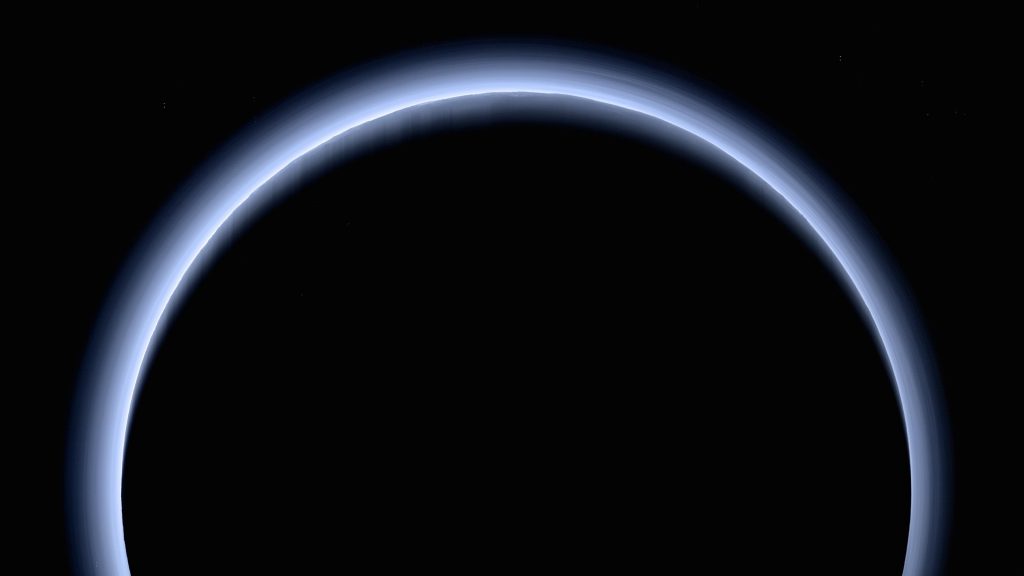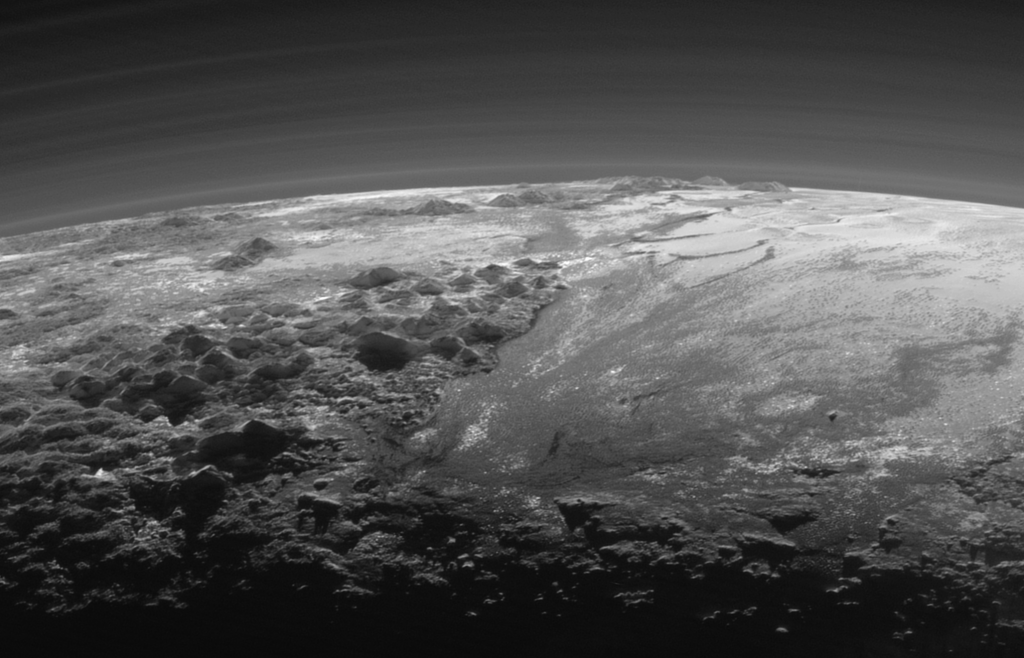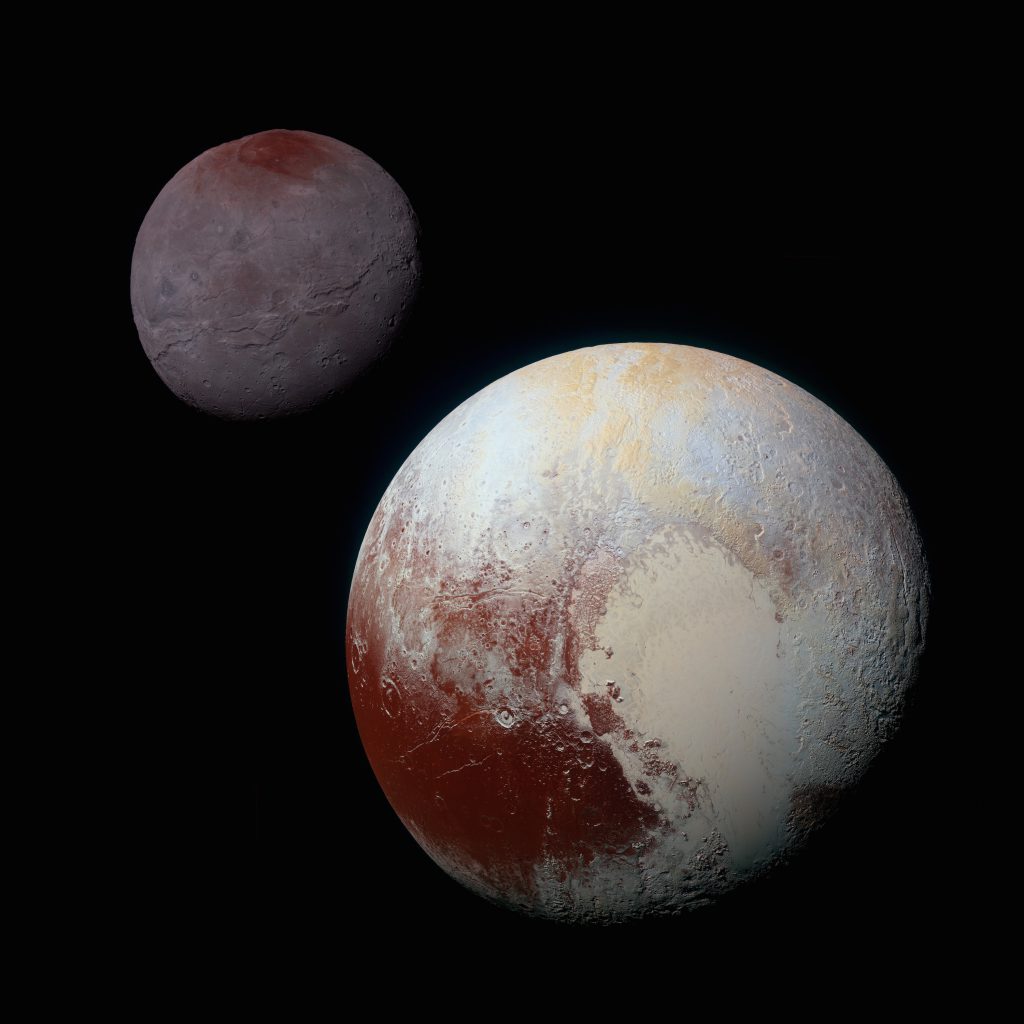Dwarf Planet Pluto
By Begüm Nisa Kasaplı
Pluto is a dwarf planet of the Kuiper Belt, which is a group of objects orbiting in a disc-like zone beyond the orbit of Neptune. This distant realm is populated with thousands of miniature icy worlds that formed about 4.5 billion years ago in the history of our solar system. Pluto, which is a member of the Kuiper Belt, is smaller than Earth’s Moon. Also due to its lower density, Pluto’s mass is about one-sixth that of Earth’s Moon. Its blue skies, spinning moons, mountains as high as the Rockies, and red snows make it a fascinating world.

With a radius of 715 miles (1,151 kilometers), Pluto is equivalent to about 1/6 the width of Earth. Therefore, if we consider Earth the size of a nickel, Pluto would be the size of a popcorn kernel. Due to its average distance of 3.7 billion miles, Pluto is 39 astronomical units from the Sun. An astronomical unit which is abbreviated as AU corresponds to the distance between the Sun and the Earth. Because of this distance from Pluto, the Sun here is 1/900th as bright as on Earth, or about 300 times as bright as our full moon.
The first close-up images of Pluto and its moons were provided by the historic flyby of NASA’s New Horizons spacecraft on July 14, 2015. With data from this mission, assumptions about the possibility of Pluto being an inactive ice ball were found by some scientists to be inconclusive.
“It’s clear to me that the solar system saved the best for last! We could not have explored a more fascinating or scientifically important planet at the edge of our solar system. The New Horizons team worked for 15 years to plan and execute this flyby and Pluto paid us back in spades!” – Alan Stern, New Horizons Principal Investigator from the Southwest Research Institute in Boulder, Colorado
Pluto is a complex and mysterious world with mountains, valleys, plains, craters, and even glaciers. After its discovery in 1930, Pluto was considered the ninth planet of our solar system. But, not long after the discovery of similar attractive worlds in the distant Kuiper Belt, little Pluto was reclassified as a dwarf planet.

The height of Pluto’s highest known mountains is between 6,500 and 9,800 feet (2 to 3 kilometers). The mountains are big blocks of water ice sometimes covered with ices of methane. Long troughs and valleys as long as 370 miles (600 kilometers) make this dwarf planet even more interesting. Some craters, which are as large as 162 miles (260 kilometers in diameter), indicate signs of past erosion and filling. This suggests tectonic forces are slowly resurfacing Pluto. The most prominent plains observed on Pluto appear to be made of frozen nitrogen. These plains show structures suggesting past convection — which is when blobs of material circulate up and down within the crust.
Pluto is approximately 1,400 miles wide, which is thought to be only half the size of the United States. Another assumption is that Pluto, about 3.6 billion miles from the Sun, has a thin, tenuous atmosphere that expands when it comes closer to the Sun and collapses as it moves farther away, similar to a comet. In addition as Pluto gets closer to the Sun, the ice on its surface is predicted to sublimate and rise to temporarily form a thin atmosphere. Pluto’s low gravity, which is about 6% of Earth’s, can cause the atmosphere to expand in altitude much more than our planet’s atmosphere. Pluto is thought to become much colder during the part of each year when it is traveling far away from the Sun. During this time, some of its atmosphere may freeze and fall to the surface as snow.
Pluto’s atmosphere is composed mostly with nitrogen, methane, and carbon monoxide. The. ice covers the surface due to the freezing of methane and nitrogen, and that makes this view interesting. On average, Pluto’s temperature is -387°F (-232°C), and this situation makes it too cold to sustain life as we know it (at least at the surface). Water, vital to life here on Earth, is known to be essentially rock-like at these cold temperatures. But Pluto’s subsurface may be warmer and may even have oceans deep inside (though this is highly debated). Pluto may even have a rocky core surrounded by a mantle of water ice. Due to its lower density, Pluto’s mass is about one-sixth that of Earth’s Moon.
Pluto’s orbit around the Sun, both elliptical and tilted, is unusual compared to the terrestrial and jovian planets. Pluto’s 248-year oval-shaped orbit can take it as far as 49.3 AU from the Sun, and as close as 30 AU. From 1979 to 1999, Pluto was near perihelion, when it is closest to the Sun. During this time, Pluto was actually closer to the Sun than Neptune. Pluto’s axis of rotation is inclined 57 degrees relative to its orbital plane around the Sun. Because of this, it almost turns on its side relative to most of the planets. Pluto also exhibits retrograde rotation, it rotates from east to west like Venus and Uranus. Pluto completes one rotation in 153 hours. This corresponds to a day on Pluto. It is unknown whether Pluto has a magnetic field, but its small size and slow rotation suggest it has little or no magnetic field.
Moons

Pluto has five known moons: Charon, Nix, Hydra, Kerberos, and Styx. The reason for this moon system is thought to have been formed as a result of the collision of Pluto with an object of similar size in the history of the solar system. Charon, the biggest of Pluto’s moons, is approximately half the size of Pluto. This makes it the largest satellite relative to the world it orbits in our solar system. It orbits Pluto at only 12,200 miles (19,640 kilometers) away. For comparison, that’s equivalent to 1/20th of the distance between our Moon and Earth. For this reason, Pluto and Charon have been referred to as a double planet. Charon’s orbit around Pluto takes 153 hours, that’s the same time it takes for Pluto to complete one rotation. This means that Charon neither rises nor sets, but rests over the same spot on Pluto’s surface. The same side of Charon always faces Pluto — this is called tidal locking. Pluto’s other four moons are much smaller and they are less than 100 miles (160 kilometers) wide. They also have irregular shapes, not spherical like Charon. Unlike many other moons in the solar system, these moons are not tidally locked to Pluto.
Namesake
Pluto is the only world (so far) named by an 11-year-old girl. On March 14, 1930, Venetia Burney was having breakfast with her mother and grandfather. Her grandfather was very excited about what it would be named after he read in the newspaper about the discovery of a new planet. Venetia asked, “Why not Pluto?”. She knew what this name meant from mythology books. Pluto in Roman mythology is the god of the underworld. Venetia had no idea that her suggestion led to a planet’s name, but her grandfather had been the head librarian in the Bodleian at Oxford. He told the astronomer Herbert Hall Turner, whom he knew from university, and Herbert Hall Turner was surprised why they had not thought of this name before. Her grandfather later shared this good news with Venetia, who was unaware of anything. Thus, Pluto got its name.

“Pluto is the name of the Roman god of the Underworld, equivalent to the Greek Hades. However, the Greek name “Plouton” (from which the Romans derived their name “Pluto”) was also occasionally used as an alternative name for Hades. But Pluto is definitely the Roman spelling.” – Dr. Elizabeth Vandiver, chair of the Department of Classics in Whitman College in Walla Walla, Washington.
The discovery of Charon which is Pluto’s largest moon also has a different story. Astronomer James W. Christy observed what appeared to be a bump on Pluto’s edge while examining images taken with a telescope in 1978. He realized that this bump might be animated when he looked at the pictures. He was certain that something was swirling around Pluto, and he knew it was a satellite. He wanted to use the word “Char”, which was an abbreviation of his wife, Charlene Christy’s name. James W. Christy, who is also interested in physics, brought the suffix -on, which is found in electron and proton, to this word. And the name became as Char-on. When he presented it, learning that the name must have a meaning, Jim Christy searched for the word in dictionaries and found the word Charon, meaning the boatman that ferried dead souls across the river Styx in some ancient Greek stories.
Later, the other satellites of Pluto also took their names from mythology. Nix is named for the mother of Charon, who is also the goddess of darkness and night; Hydra is named for the nine-headed serpent that guards the underworld; Kerberos is named after the three-headed dog of Greek mythology, and Styx is named for the mythological river that separates the world of the living from the realm of the dead.
As a conclusion, Pluto is a wonderful dwarf planet in many ways, including its atmosphere, geographical formations, and moons. Over time, many mysterious aspects have been discovered. With the discovery of the Kuiper belt, a lot of information about Pluto was shed. The fact that it is called a double planet with its satellite Charon should make them one of the incredible objects in space.
Reference
https://solarsystem.nasa.gov/planets/dwarf-planets/pluto/overview/
Begüm Nisa Kasaplı is an undergraduate at Bahçeşehir University and a Research Associate for the BMSIS Young Scientist Program. She is working with Dr. Cassandra Juran on the differentiation of osteoblasts.
